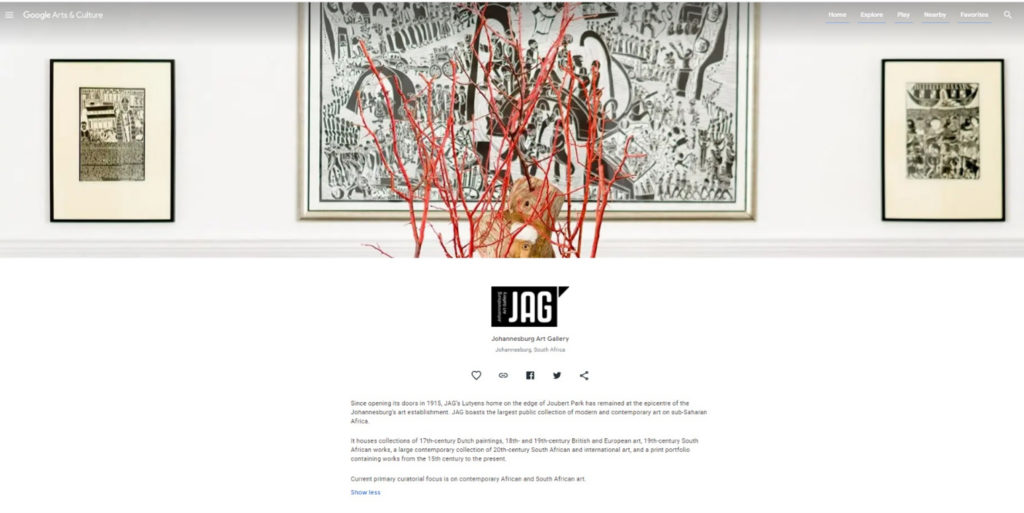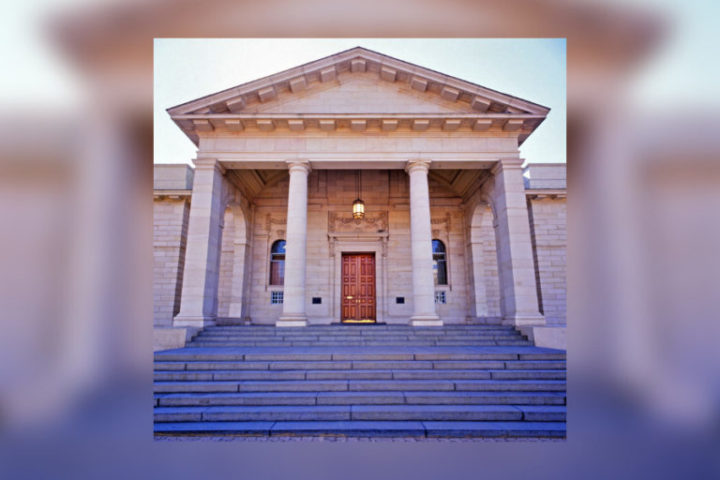
Philippa van Straaten
Curator at the Johannesburg Art Gallery
Museums have no borders,
they have a network
June 1, 2022
As with most heritage institutions worldwide, the Covid-19 pandemic posed many personal and professional challenges for the Johannesburg Art Gallery (JAG) and its staff throughout the last two years. The impact of JAG’s closure to visitors from March 2020 until early December 2021 alongside recurring issues around public access, staff capacity and new ways of virtual working has been huge. Simply put, the recent closure has forced us to look at how JAG operates physically and ideologically inside and outside the confines of the Gallery precinct. JAG staff have also had to examine what needs to happen inside the storerooms, archives, and exhibition halls going forward in order to increase access, particularly with the global push to tack on online and digital formats, alongside physical displays or programming.

The need to improve access(es) to JAG
How to grab the attention of the public and communities around the JAG precinct and other local and international visitors has long been a topic for serious discussion and numerous engagements. Projects such as the Joubert Park Project in 2001, Urban Concerns in 2008, both of which featured the Park and JAG extensively, sought to investigate the role of the arts as social and political actors within their environment and communities. JAG is positioned within the bustling, contested suburb of Hillbrow, and is a densely populated, urban mixture of informal traders, transient travellers and workers, and a melting pot of local and foreign residents. The pandemic has made access to JAG even more difficult, complicated by its supposed ideologies based on collecting history and its colonial beginnings. Successful public access may only be achieved where the Gallery engages actively with and challenges its collections in new ways that would encourage fresh discussions around the institution’s relevance and its place within Johannesburg’s cultural and art economy, in the digital age.
The current Ngoma II exhibition, which follows on from the first engages with the Gallery’s collections to examine the cosmologies inherent in and across JAG’s artworks, approaches a topic that addresses one’s place in the world and ancestral and spiritual realms. Much consideration was given to online audience engagement, and visitors engage with the exhibition in the physical space and on online platforms. Ngoma II was also the second of JAG’s exhibitions to be 3D-rendered for placement online during the pandemic lockdowns, and the first to be ‘opened’ via streaming on Facebook through the City of Johannesburg channels. This exhibition presents possibilities for JAG to run future programmes in similar ways.
The need to get with the (digital) programme
For a long time, JAG had been seeking ways to expand its digital presence, and Covid-19 offered the opportunity for the its staff to pursue archiving and digital projects in meaningful ways, alongside its usual physical programming. In 2019, through the Friends of the Johannesburg Art Gallery, JAG was awarded funding from the US Ambassador’s Fund for Cultural Preservation, in order to carry out large-scale digitisation of the Federated Union of Black Artists (FUBA) archives held at JAG, and begin processes to enable the material to be made available online. While this project was conceptualised before the pandemic, its implementation has been shaped by considering the archive as a digital entity, and what needs to happen going forward to make the material accessible online. The pandemic has forced fresh thinking around challenges- such as the lack of access to technological and human resources, the lack of social media for JAG and perhaps most importantly, the fact that a majority of the JAG collections, both on display and in storage, have not yet been digitised. Some of these challenges have been mitigated by working within systems, such as using ‘unofficial’ accounts on social media to broadcast events, like the Joburg Culture Facebook page, which acts as a repository for all the City of Johannesburg cultural institutions’ online media. JAG’s storerooms are full of vibrant, valuable, contemporary and historic pieces that have for too long been silent as a result. Large-scale photography and digitisation of the objects in the collections will be perhaps the single most important project to undertake in these uncertain times, and one that will unlock so much additional content for further digital or hybrid programming. The pandemic has pointed out major flaws inherent in the institution’s unpreparedness for online and digital ways of working, and its capacity to provide digital museum and record-keeping services to its varied audiences. We quickly realised that digitisation is not a simple, one-step process, but a time- consuming, intense and expensive undertaking.
Conclusion
The pandemic highlighted that? digitisation would allow the JAG team to create online content and virtual exhibitions more easily. Apart from the fledgling attempts at placing exhibitions online recently, the Johannesburg Art Gallery also has a page on Google Arts and Culture website, but this only represents a small portion of what JAG’s holdings are. JAG’s Chief Curator, Khwezi Gule, also highlights the fact that digital landscapes and data cycles change rapidly, and along with this is the greater need to update communication and related technology more often. There is a huge need to move with the times, or risk being left behind. Across the culture and heritage events and programming are increasingly online or alongside physical exhibitions, and if JAG had the basic digital building blocks it could create so much more, he says?

Gule suggests numerous, collaborative ways in which JAG could produce more in the digital sphere in the future, apart from digitisation. One idea is for JAG to become an online hub for mainly local artists and creatives to come together to run programmes, offer or attend curatorial, content creation and programming workshops, and share and create content. He also sees JAG publishing more online, whether in the form of publications, or more collection or public programming content that would appeal to learners, researchers and those curious and interested in the works held at JAG. Creative partnerships with like-minded organisations and developing new networks have become key in achieving this goal.
However, Gule cautions against neglecting physical exhibitions, and highlights the fact that traditional media have still not been overshadowed by digital communication. When asked how he sees the Gallery working in a year’s time, JAG’s Chief Curator says:
‘In the same way the film did not replace the photograph, [e-books] did not replace books, for JAG the online or digital component is just another ingredient in the mix of communication channels at our disposal, with unique opportunities and drawbacks’.
Resources and references
See Terry Kurgan’s article on Joubert Park Project: http://www.terrykurgan.com/project/joubert-park-project/
The City of Johannesburg released this press release about the Urban Concerns collaboration with the Bildmuseet in 2008: http://www.sharlenekhan.co.za/articles/Press/13.%202008%20Urban%20Concerns.pdf
NGOMA II – Cosmology in African Modernities, Facebook livestream: https://fb.watch/bQ01mMZmuQ/
Johannesburg Art Gallery ‘s page on Google Arts and Culture: https://artsandculture.google.com/partner/johannesburg-art-gallery
